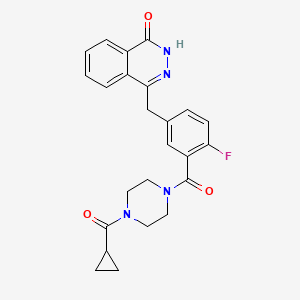Olaparib, 763113-22-0, AZD2281, Lynparza, AZD-2281, KU-0059436, AZD 2281, 1-(Cyclopropylcarbonyl)-4-[5-[(3,4-dihydro-4-oxo-1-phthalazinyl)methyl]-2-fluorobenzoyl]piperazine, OLAPARIB cpd, 4-(3-(4-(Cyclopropanecarbonyl)piperazine-1-carbonyl)-4-fluorobenzyl)phthalazin-1(2H)-one, KU-59436, UNII-WOH1JD9AR8, WOH1JD9AR8, Olaparib (AZD-2281), Olaparib (AZD2281, Ku-0059436), Olaparibum, Olaparib [USAN:INN], AZ2281, NSC-747856, AZD221, CHEBI:83766, 4-[[3-[4-(Cyclopropanecarbonyl)piperazine-1-carbonyl]-4-fluorophenyl]methyl]-2H-phthalazin-1-one, MFCD13185161, AZ-2281, KEYLYNK-010 COMPONENT OLAPARIB, KU59436, KU 59436, 4-(3-{[4-(Cyclopropylcarbonyl)piperazin-1-Yl]carbonyl}-4-Fluorobenzyl)phthalazin-1(2h)-One, 4-[3-(4-Cyclopropanecarbonyl-piperazine-1-carbonyl)-4-fluoro-benzyl]-2H-phthalazin-1-one, NSC 747856, OLAPARIB COMPONENT OF KEYLYNK-010, OLAPARIB (MART.), OLAPARIB [MART.], Olaparib (DISCONTINUED), Olaparib [INN], (2H)-Phthalazinone, 4-((3-((4-(cyclopropylcarbonyl)-1-piperazinyl)carbonyl)-4-fluorophenyl)methyl)-, 1(2H)-Phthalazinone, 4-[[3-[[4-(cyclopropylcarbonyl)-1-piperazinyl]carbonyl]-4-fluorophenyl]methyl]-, 4-[(3-{[4-(Cyclopropylcarbonyl)piperazin-1-yl]carbonyl}-4-fluorophenyl)methyl]phthalazin-1(2H)-one, PIPERAZINE, 1-(CYCLOPROPYLCARBONYL)-4-(5-((3,4-DIHYDRO-4-OXO-1-PHTHALAZINYL)METHYL)-2-FLUOROBENZOYL)-, Olaparib (AZD2281; Ku-0059436), C24H23FN4O3, Olaparib (AZD2281), 4-(3-((4-(cyclopropylcarbonyl)piperazin-1-yl)carbonyl)-4-fluorobenzyl)phthalazin-1(2H)-one, 4-[3-[4-(Cyclopropanecarbonyl)piperazine-1-carbonyl]-4-fluorobenzyl]phthalazin-1(2H)-one, Olaparib- Bio-X, Lynparza (TN), 09L, 1(2H)-PHTHALAZINONE, 4-((3-((4-(CYCLOPROPYLCARBONYL)-1-PIPERAZINYL)CARBONYL)-4-FLUOROPHENYL)METHYL)-, 4-((3-((4-(CYCLOPROPYLCARBONYL)PIPERAZIN-1-YL)CARBONYL)-4-FLUOROPHENYL)METHYL)PHTHALAZIN-1(2H)-ONE, 4-((3-{(4-(cyclopropylcarbonyl)piperazin-1-yl)carbonyl}-4-fluorophenyl)methyl)phthalazin-1(2H)-one, 4-[[3-[[4-(Cyclopropylcarbonyl)-1-piperazinyl]carbonyl]-4-fluorophenyl]methyl]-1(2H)-phthalazinone; AZD 2281; KU 0059436; KU 59436; 1-(Cyclopropylcarbonyl)-4-[5-[(3,4-dihydro-4-oxo-1-phthalazinyl)methyl]-2-fluorobenzoyl]piperazine;, AZD2281(olaparib), OLAPARIB [USAN], OLAPARIB [JAN], OLAPARIB [MI], OLAPARIB [VANDF], OLAPARIB [WHO-DD], AZD-2281 (Olaparib), PARP inhibitor AZD2281, Olaparib (JAN/USAN/INN), 937799-91-2, MLS006010185, SCHEMBL426568, Olaparib, KU-0059436, OLAPARIB [ORANGE BOOK], CHEMBL521686, GTPL7519, BDBM27566, DTXSID60917988, EX-A002, L01XX46, FDLYAMZZIXQODN-UHFFFAOYSA-N, BCPP000360, GLXC-02796, HMS3295I09, HMS3426C03, HMS3654G13, HMS3746K07, HMS3870H03, AMY10295, BCP01872, 763113-22-0, Lynparza,, NSC747856, NSC753686, s1060, AKOS005145764, AC-7939, BCP9000363, CCG-264799, CS-0075, DB09074, EX-7210, NSC-753686, SB14617, SS-4573, AZD2281,Olaparib, KU-0059436, NCGC00238451-01, NCGC00238451-02, NCGC00238451-08, NCGC00238451-09, NCGC00238451-11, 4-[(3-{[4-Cyclopropylcarbonyl)piperazin-4-yl]carbonyl}-4-fluorophenyl)methyl]phtalazin-1(2H)-one, 4-[[3-[[4-(Cyclopropylcarbonyl)-1-piperazinyl]carbonyl]-4-fluorophenyl]methyl]-1(2H)-phthalazinone, 4-{[3-(4-cyclopropanecarbonylpiperazine-1-carbonyl)-4-fluorophenyl]methyl}-1,2-dihydrophthalazin-1-one, BO164169, HY-10162, SMR004701291, SY040527, A9666, FT-0651458, NS00072449, SW218142-2, D09730, EN300-7542225, J-503540, Q7083106, AZD2281 , KU0059436, BRD-K02113016-001-08-9, BRD-K02113016-001-09-7, Z2227698469, 1-(cyclopropylcarbonyl)-4-[5-[(3,4-dihydro-4-oxo-1-phthalazine, 4-(3-(1-(cyclopropanecarbonyl)piperazine-4-carbonyl)-4-fluorobenzyl)phthalazin-1(2H)-one, 1021843-02-6, 4-({3-[(4-cyclopropanecarbonylpiperazin-1-yl)carbonyl]-4-fluorophenyl}methyl)-1,2-dihydrophthalazin-1-one



